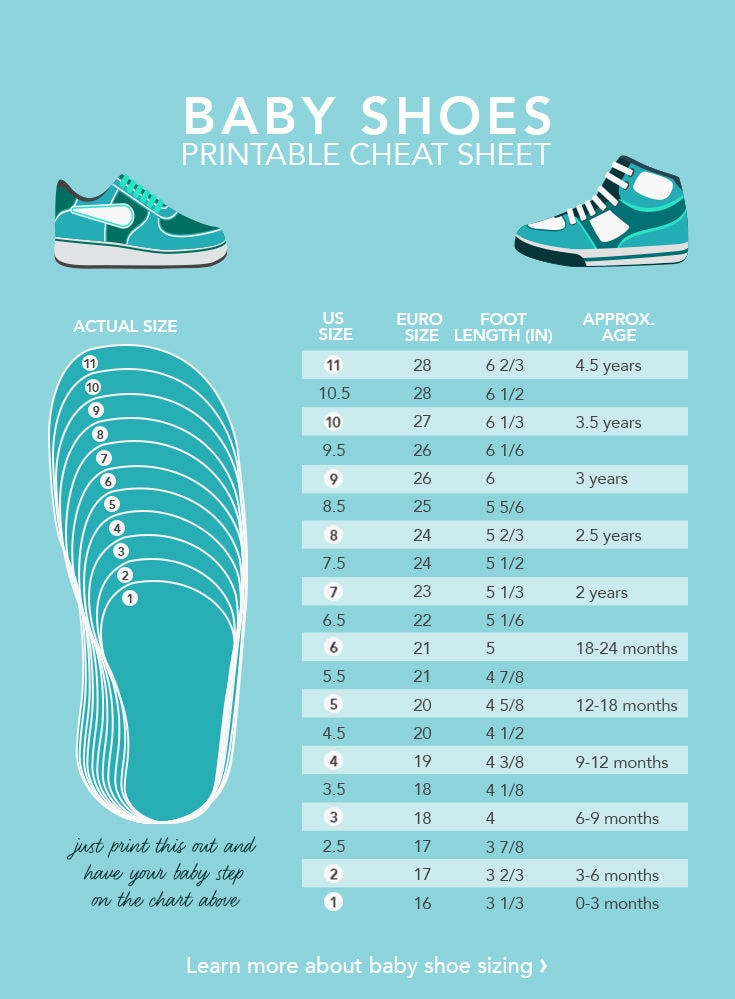It seems a shame to hide your tot’s scrumptious little feet — but, especially in the early months, you’ll want to keep her toes covered and cozy. When she’s about to take her first steps, familiarizing yourself with baby shoe sizes will help you get a good fit.
[RELATED: “Baby Clothes Sizes — Solving the Mystery!“]
“Before a baby starts to walk, shoes are only necessary for warmth,” notes Dr. Jane Andersen, a Chapel Hill, North Carolina, podiatrist and spokesperson for the American Podiatric Medical Association.
After your child begins walking, she’ll need footwear to protect her from the elements, and sometimes for traction. (This is why it’s important for you and any nannies, babysitters or infant child care you hire to keep a close eye on your kiddo during walks — especially she’s the kind of kid who loves chucking her clothes out of the stroller.)
During the early months, you can dress your baby’s feet in socks or booties, and once she’s ready for a ‘real shoe,’ look for quality.
“A baby shoe made of soft leather is ideal, as it provides good flexibility in the sole,” says Dr. Andersen.
Babies who cruise and walking toddlers can also wear sneakers and sturdy sandals. The shoes you purchase shouldn’t need to be ‘broken in’ to be worn. They should fit comfortably from the start.

Does the Shoe Fit?
Because baby shoe sizes can vary between footwear brands and manufacturers, it’s important to have your child’s feet measured by a shoe professional. Once you have the length in inches, you can seek out a comfortable fit. Keep in mind that some stores label shoes only by age and tend to use wider ranges (for example, 6-12 months or 12-18 months).
“If you have a professional measure your child’s foot every three months, you’ll be able to track whether she’s outgrowing her shoes,” says Dr. Louis DeCaro, a podiatrist in West Hatfield, Massachusetts, and president of the American College of Foot and Ankle Pediatrics. You can also use the pinkie rule to check for fit — your baby’s shoe should be one (adult) pinkie width longer than her foot.
As a general guide, use the following chart of baby shoe sizes, which shows foot length matched to each approximate age. This chart works for most shoe styles your baby will wear at these ages, including sneakers, sporty sandals and boots.
Shoe Sizes
- Size 1 (Euro Size 16)
Length: 3 1/2 inches. Approximate Age: 0-3 months
- Size 2 (Euro Size 17)
Length: 3 5/8 inches. Approximate Age: 3-6 months
- Size 2.5
Length: 3 7/8 inches. Approximate Age: 3-6 months
- Size 3 (Euro Size 18)
Length: 4 inches. Approximate Age: 6-9 months
- Size 3.5 (Euro Size 18)
Length: 4 1/8 inches. Approximate Age: 6-9 months
- Size 4 (Euro Size 19)
Length:4 3/8 inches. Approximate Age: 9-12 months
- Size 4.5 (Euro Size 20)
Length: 4 1/2 inches. Approximate Age: 9-12 months
- Size 5 (Euro Size 20)
Length: 4 5/8 inches. Approximate Age: 12-18 months
- Size 5.5 (Euro Size 21)
Length: 4 7/8 inches. Approximate Age: 12-18 months
- Size 6 (Euro Size 21)
Length: 5 inches. Approximate Age: 18-24 months
Here are a few other smart tips for buying and fitting your baby’s shoes:
- Shop Together
Take babies along when looking for footwear and put him in the socks he’ll be wearing with the shoes you’re buying. You should also shop in the afternoon as feet tend to swell as the day goes on. (Fitting them when they’re at their largest is best.) And be sure to buy shoes for the bigger foot, because feet aren’t always the same size.
- Skip the Trends
Say no to combat boots, flip-flops, wedges, strappy sandals or heels of any kind for your baby or toddler. They may seem super cute but the fashionable baby shoes can be difficult to walk in. “These shoes are too restrictive and may inhibit normal gait patterns and muscle development,” warns Dr. Andersen.
Many stores carry a wide range of shoes for babies and kids, so take your time when shopping for footwear. “Seek out what fits best, regardless of the age range or size that’s stamped on the shoe,” advises Dr. DeCaro. Your baby’s feet will thank you!
Curious about more than just baby shoes? Check out Baby Clothes Sizes — Solving the Mystery!
Jennifer Kelly Geddes is a New York-based writer and editor who specializes in parenting, health and child development. She’s a frequent contributor to Care.com and the mom of two teen girls.
